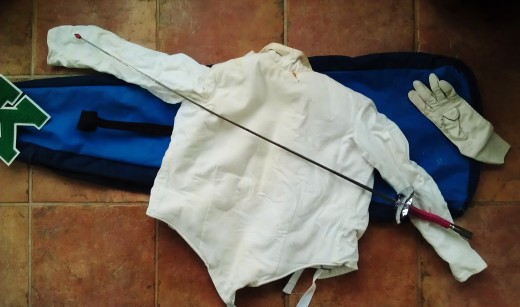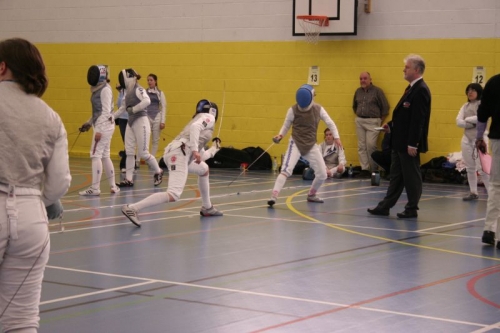Left Handed Fencing for Girls -- What are the Advantages? Foil Epee Sabre Gear
My left-handed fencing gear, almost thirty years later..

About one in ten people are left-handed, but thirty to fifty percent of the world's top fencers are left-handed...
I never was that great at organized sports, but found that I had an advantage being left-handed when I started foil fencing as a freshman girl in high school... And ended up going to the Olympics. Okay, it was the Junior Olympics, and I didn't last long, but for someone who struggled in just about every other sport it was a proud accomplishment.
The thing is, if you fence with your left hand, you are sparring with right-handed people who have (mostly if not only) practiced against other right-handed fencers. All of a sudden, there you are leading with your left hand and all of their practiced moves don't work! Everything seems backwards--they need to figure out how to do mirror image fencing.
In the world's population, about ten percent of males are lefties, but only about eight percent for the females. Unless all people who are dominant left take up fencing, there is a good chance that you will have an advantage in this sport when you come at them from a new perspective. It's always a good idea to also practice against another leftie (if you can find one!) otherwise you may struggle sparring against a left-handed opponent and have to reconfigure your moves--just like a right-handed fencer must do when confronted with you!
Left-handed female vs right-handed female

Is fencing good exercise?
Fencing is great if you want to
- Be strong and flexible
- Have great hand to eye coordination
- Get an aerobic workout
- Learn how to use a sword!
Fencing will get you in good shape. A good fencer has a long lean physique-- not with bulging muscles but very strong and very flexible. It's a great aerobic workout because you are constantly moving, almost like a combination between dancing and martial arts --with a sword.
Interestingly enough, my competitive spirit started waking up when I was fencing. When I did cross-country, I would mostly run to beat my own time, and I didn't really care how I placed against the other runners. But fencing brought out something different in me that I hadn't seen before, and haven't seen since.
Why fencing?
Besides being great exercise for mind and body, what is so cool about fencing?
- Classic historical sport
- Elegant and cool
- Sword fighting in a controlled safe way wearing protective clothing
- Unusual
Fencing has been more or less the same for years. We've all seen movies with fencing duals and the basics are still the same -- One big change is that now during official duals, both fencers wear electric vests so scoring is more easily judged.
There is just something cool about fencing. The history, the moves, the outfit, and the sword. how often to you get to use a sword in regular life? There is something daring and outrageous about participating in a sport that has been adapted for safety (buttons on the ends of the swords, protective gear, specific rules) but still retains the same spirit of one on one combat.
This is not to say that fencing as a sport encourages fighting-- rather, it encourages good sportswomanship, strategy, and a finely tuned sense of competition
The many reasons to start with foil according to an experienced fencer: student, teacher, and best-selling author
- Starting with Foil
Fencing and rapier instruction, practice, and display, also smallsword and western swordsmanship
What type of fencing is right for you? Foil, sabre, or epee?
There are three types of fencing, each with a different type of sword and different rules of combat. Fencers in all three types of fencing wear similar types of protective clothing.
In foil fencing:
- The sword: has a rectangular blade. (Think long metal sugar cube). It is long and flexible and only the tip is used on the opponent. For safety against punctures, there is a metal "button" on the end of the sword.
- Target area: torso area only, (chest and back), not arms.
- To score: Hitting the target area of your opponent with the tip of your sword.
In sabre fencing:
- The sword: has a V-shaped blade similar to an epee sword, but is more flexible. The tip of sabre swords are folded for safety, although there is no actual metal button.
- Target area: anywhere above the waist except the hands-- torso, arms, and even head are target areas.
- To score points: Hit the target areas using both the tip and sides of the sword.
In epee fencing:
- The sword: Similar to foil, but V-shaped instead of rectangular and not as bendy.
- Target area: Entire body
- To score points: Tip of sword
When I was a fencer in the 1980s, girls were only allowed to do foil fencing. Of course this made me want to try the others, but I ended up being a life-long fan of the foil. Foil is classic fencing--the place where all fencers should start.
Fencing equiptment: What gear do you need?
Once you decide to start fencing, the four essential things to get first are:
- Helmet
- Vest
- Glove
- Sword
Helmet: It's important to wear your protective gear --especially the helmet-- whenever you fence. Even if you are just having a quick practice, get that helmet on! The gear takes some getting used to. The helmet muffles sound and especially vision at first. You look out through a meshed wire grating. The mesh is fine, but very strong, and believe me-- you want a strong protective field between your face (eyes!) and a thrusting sword. Fencing is a demanding, sweaty sport, but if you are facing another fencer and the tips of your swords are off the ground, you need to be wearing that helmet.
Fencing jacket: this is a padded white vest with long sleeves that has a strap between the legs to keep it from riding up. All female fencers should wear metal breast protection discs, (or similar protection), and many males wear chest protection as well because the repeated stabbing in this area can cause serious problems otherwise. Even with the metal plates, it is not a small thing to get a running sword blow straight to the chest. Many fencing jackets at the time had front left side fastenings, (because the right side of the body would be the main target) but my jacket had a zipper in the back--impossible to put on by myself!
Glove: white protective glove.
Sword: foil, epee or sabre?
Also inside my bag I carried
- white cotton fencing trousers
- white knee-socks
- white tennis shoes
The left-handed advantage
Once you have your equipment and your fencing mistress or master, you are ready to start practicing. For me, this is when I noticed something. I had an advantage.
Right-handed fencers mostly fence against other right-handed fencers, so when they encounter a left-handed opponent this puts them at a disadvantage. Fencing is a strategic sport with specific rules but it is also a reaction sport, and it is hard to react with learned and practiced strategies when the opponent is doing everything backwards!
I struggled the first time I fenced against another left-handed fencer (which only happened once), but it is possible that there are more lefties fencing now than when I was in high school.
World Championship, left vs right females-- a very close match
My fencing experience
I am left-handed, and have a very strong left arm. I used this advantage, and learned how to outmaneuver my opponents. There were about twenty guys and three girls in fencing at my high school. I fenced against were much better technically and had a hugely higher level of strength, but I could often beat them.,, at least until they got used to fencing with me and reorganized their strategies.
The second year I was on the fencing team I was chosen to go to the Junior Olympics.
The big day, my first set of competitions at the Junior Olympics was held in a high school gymnasium in a nearby big city. There wasn't a huge crowd-- maybe fifty spectators hanging around the edges of the gym. I was excited. My first real competition, and I was going to nail it. Who said I wasn't good at sports?! This was the Junior Olympics-- who knew --maybe I would go on to the Olympics!
Then, my first match. I had to put on a metal vest which was attached to a cord that pulled out from my back to a machine. If my opponent touched my target torso area hard enough to bend her foil, the buzzer would sound and a point against me. I had never practiced with this equipment. It was a disaster. Every time I lunged forward I was conscious of the tether and it distracted me. I felt off balance and uncomfortable. Two matches later and I was disqualified.
Even with my left-handed advantage, I only scored a few strikes in both matches-- I had an advantage, but I wasn't prepared.
If you are thinking about starting fencing, I highly recommend it. It is a sport that will challenge you physically and mentally, improve your strength, agility, and coordination, and train you in the timeless and classic-- yet unusual!-- skill of sword fighting. En guarde!







